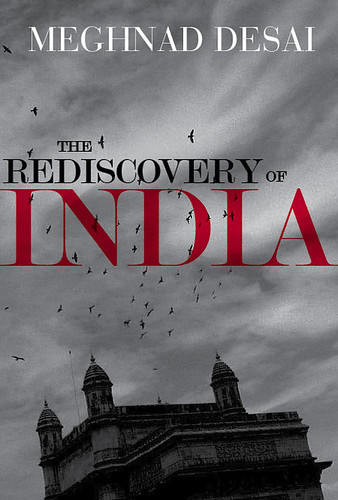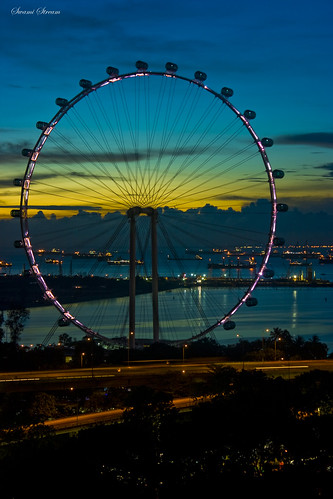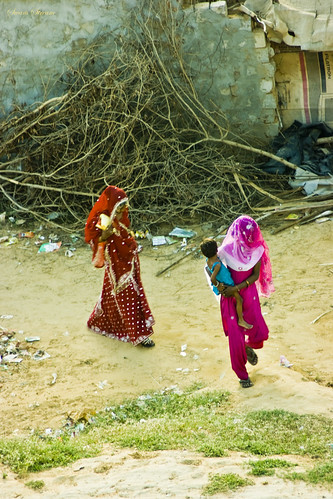The Rediscovery of India
This is book cover of "The Rediscovery of India " by Meghnad Desai Pubished by Penguin books which is my photo
www.flickr.com/photos/araswami/541424920/
The books details are on this site
www.penguinbooksindia.com/Bookdetail.aspx?bookId=3760
I am very excited this is my first book cover.
Uploaded by Swami Stream on 27 Nov 09, 1.26PM IST.
The Rediscovery of India
Buildings on Singapore River
Shot of the buildings along the Singapore River .
Info from Wikipedia
The mouth of the Singapore River was the old Port of Singapore, being naturally sheltered by the southern islands. Historically, the city of Singapore initially grew around the port so the river mouth became the centre of trade, commerce and finance. To this day, area around the old Singapore River mouth, the Downtown Core, remains the most expensive and economically important piece of land in Singapore.
At one time, Singapore River was the very lifeblood of the colony, the trade artery, the center of commercial activity, the heart of entrepot trade, the vessel of importance, the capillaries of life and the place which was frequented by the secret societies, the swaylos (Cantonese for coolies who worked on a boat) and the coolies who worked for the philanthropist Tan Tock Seng at Ellenborough Market and the towkay (Hokkien for business owner) Tan Kim Seng who was busy filling his godown with the riches of the East.
Singapore River is where the colourful and romantic history of the river and the myths and legends can still conjure up memories of the lighters, bumboats, tongkangs with their painted eyes to see the danger ahead and sampans of yesteryear. This is where the Malayan princes once sailed and this is where the bullock carts plodded their way up and down each bank as the river found its way to the former rocky river mouth. This is also where an early civilisation was conquered by the Javanese Majapahit Empire, in the year 1376.
It was here too that the Chinese lived, on the south bank, the Malays in kampongs further upstream, and the Indians used to reside until the Chinese forced them out to Rochor, Kallang and Geylang.
Some of the temples, shrines and other places of worship still stand in the vicinity of the river. So too are the godowns, the bridges such as Anderson Bridge, Elgin Bridge and Cavenagh Bridge, the Merlion, the shophouses, and the large trees such as Banyan and Madras Thorn. Some parts of this area include quays such as Clarke Quay and Boat Quay, which generated trade and extensive demand for services with the boats that landed at the quays. Boat Quay itself was handling three quarters of the shipping service in the 1860s. Shophouses and warehouses flourished around the quays due to their proximity to trade during the colonial era, but presently house various bars, pubs and restaurants, as well as antique shops.
The river still borders places where seamen and others, for example, near Raffles Landing Place, made offerings and burned their joss sticks. Poles with streamers flying were once used to tie up the barges as the water lapped against the old stone steps and walls.
Sir Stamford Raffles lost no time after January 1819, when he landed on Singapore River among the orang laut and the human skulls, the victims of river pirates, in bargaining with the Temenggong, the Johor chief who then ruled the place, having settled in 1811. At the very moment of landing, Raffles must have realised the importance of the river for, in the same year of 1819, the north bank was drained for government buildings and, in 1822, the south bank was reclaimed and a retaining wall and steps were built.
With the expansion of trade came congestion and pollution. Through lack of knowledge or foresight, the bridges were constructed too low and the river was too shallow for the demands that were to be made on its use. This historic river, which Raffles had fashioned from salt marshes, sand bars and mangrove swamps, has witnessed the British rule and the Japanese occupation, and has supported years of economic activity by the Chinese, Malays, Indians and others.
Old maps of the river state that it actually originates from Bukit Larangan (currently Fort Canning Hill).
[edit] Pollution and cleanup
Starting in the 1880s, there was heavy traffic on the Singapore River due to rapid urbanization and expanding trade. At the same time, it brought in water pollution caused by the disposal of garbage, sewage and other by-products of industries located along the river's banks. The sources of water pollution into the Singapore River and Kallang Basin included pig wastes from pig and duck farms, unsewered premises, street hawkers and vegetable wholesaling. Riverine activities such as transport, boat building and repairs were also found along the Singapore River. Some 750 lighters plied along the Singapore River and Kallang Basin in 1977. Waste, oil spills and wastewater from these boats and lighters added to the pollution of the rivers.
In 1977, Lee Kuan Yew, then the Prime Minister put forth an ambitious goal for the government to clean up the Singapore River and Kallang Basin: and in ten years let us have fishing in the Singapore River and Kallang River. It can be done.
By October 1977, an action plan on "The Clean-up of the Singapore River and Kallang Basin" was submitted to the Prime Minister. By late 1977, the government was starting to take action to clean up the river. The plan involved the development of infrastructure such as housing, industrial workshops and sewage; massive resettlement of squatters, backyard trades and industries and farmers; re-siting of street hawkers to food centres; and phasing out of pollutive activities. Industries located by the river were removed and squatters were resettled into flats. Refuse was collected daily for incineration, while hawkers were issued licenses and provided specified areas with proper sewerage amenities. The dredging of the river bed and the removal of hundreds of tons of debris which had been piled up over the years helped marine life to return to the tidal river.
Ten years later in 1987, the clean-up of the Singapore River and Kallang Basin was completed. In September 1987, the Ministry of the Environment together with other government ministries and statutory boards celebrated the success of the clean-up with an event called the "Clean Rivers Commemoration". After the massive clean-up, people can now engage in activities such as wayang performances on a bumboat, variety shows staged on pontoons anchored in the river, and boat races. Today, speedboats, dragon boats, pedal-boats and sampans can be seen plying on the clean waterways of the Singapore River.
Uploaded by Swami Stream on 22 Nov 09, 6.11PM IST.
Singapore Flyer in Twilight
The Singapore Flyer (Chinese: 新加坡摩天观景轮 Tamil:சிங்கப்பூர் ஃப்ளையர் Malay: Pelayang Singapura) is currently the tallest Ferris wheel in the world. Described by its operators as an observation wheel, it reaches 42 stories high, with a total height of 165 m (541 ft), and is 5 m (16 ft) taller than the Star of Nanchang and 30 m (98 ft) taller than the London Eye.
Located in Singapore, on the southeast tip of the Marina Centre reclaimed land, it comprises a 150 m (492 ft) diameter wheel, built over a three-story terminal building which houses shops, bars and restaurants, and offers broad views of the city centre and beyond to about 45 km (28 mi), including the Indonesian islands of Batam and Bintan, as well as Johor, Malaysia.
The final capsule was installed on 2 October 2007, the wheel started rotating on February 11, 2008 and it officially opened to the public on March 1, 2008.[2] Tickets for rides on the first 3 nights were sold out for S$ 8,888 Singapore dollars (US$6,271)(£3,150.83GBP), an auspicious number in Chinese culture. The grand opening for the Flyer was held on 15 April 2008.
Each of the 28 air-conditioned capsules is capable of holding 28 passengers, and a complete rotation of the wheel takes approximately 37 minutes. Initially rotating in a counter-clockwise direction when viewed from Marina Centre, its direction was changed on 4 August 2008 under the advice of Feng shui masters.
The Singapore Flyer was first conceived by Patrick MacMahon of Melchers Project Management (MPM), a subsidiary of German company Melchers, in the early 2000s. Formal planning commenced in 2002, MPM and Orient & Pacific Management (O&P) formed a new company, Singapore Flyer Pte Ltd (SFPL), as the developer with MPM holding a 75% stake and the rest by O&P. The project was formally announced and endorsed by the Singapore Tourism Board (STB) with the signing of a Memorandum of Understanding on 27 June 2003, formalising the understanding between the developer and STB with regard to the land-acquisition process. As stipulated in the MOU, the STB will purchase the plot of land in Marina Centre from the Singapore Land Authority, and lease it to Singapore Flyer Pte Ltd for 30 years with an option to extend the lease by another 15 years. In addition, the land will be rent-free during the construction phase of the project. In July 2003, Jones Lang LaSalle was appointed as the real estate advisor. Takenaka and Mitsubishi were selected as the main contractors, and Arup as the structural engineer.
Early designs showed a 169 m (554 ft) high wheel similar to the London Eye, drawing criticisms that it lacked originality. The developers pointed out that the design wasn't finalised and was merely for conceptualisation purposes though the final project changed little from the early designs. The project was to grind almost to a halt subsequently when the developers faced difficulties in sourcing for funds to build the wheel. Original plans to complete the wheel by the end of 2005 were thus postponed indefinitely, and there were reports (but denied by the STB) that the tourism board has set an ultimatum date on 31 March 2005 for the developer to iron out its financial issues and to keep the development going.
By September 2005, the project was revived when funds were successfully sourced from two German banks. Collin William Page, a subsidiary of ABN AMRO, will provide equity to a maximum of S$100 million, with a further S$140 million coming from Bayerische Hypo- und Vereinsbank. With the injection of S$240 million, the largest single foreign investment in the Singaporean entertainment industry, the wheel was slated to begin construction by the end of the month.The stakeholders then were AAA Equity Holdings, MPM and O&P.
In August 2007, Mr. Florian Bollen, Chairman SFPL, raised his stake in the Singapore Flyer from 60% to 90% through acquisition of MPM’s 30% stake. The deal was done via AAA Equity Holdings, a private investment vehicle headed by Mr Bollen. O&P, which spearheaded the project development management, owns the remaining 10%.
The attraction was expected to draw about 2.5 million visitors in its first year of operation, giving investors a net yield of about 13.4%. About 50% of visitors were expected to be foreign tourists, helping to generate about S$94 million in tourism receipts in its opening year. The expected visitorship figure was deemed ambitious by some however, but the STB and the wheel's investors were upbeat over its long-term prospects.
Adval Brand Group, its master ticketing distributor, guaranteed a minimum of 8 million euros in ticket receipts per year for its investors, which was based on an annual visitorship of 600,000.
More on Wikipedia
Connought Drive Bridge (Anderson Bridge)
Shot One of the oldest Bridges in BW over Singapore river in the Central Business District in Singapore called Anderson Bridge. One can see all the tourist buses parked on this bridge from here the tourist go and see Merlion, Esplanade etc.
Anderson Bridge is a vehicular bridge that spans across the Singapore River. It is located near the river's mouth in the Downtown Core Planning Area of Singapore's Central Area.
The Anderson bridge was completed in 1910[1], and was named after the Governor of the Straits Settlements and High Commissioner for the Federated Malay States (1904–1911), Sir John Anderson, who officially opened the bridge on 12 March 1910. It formed part of the Singapore Grand Prix's Marina Bay Street Circuit, which debuted on 28 September 2008.Anderson Bridge was built with the intention to replace the overloaded Cavenagh Bridge as the link between the government administrative area in the Civic District on the northern bank and the Commercial District (now Raffles Place) on the southern bank of the Singapore River. Due to the flourishing trade on the Singapore River by the 1880s, Cavenagh Bridge could not support the increasingly heavy traffic into town. Despite the building of Ord Bridge and Read Bridge, the traffic situation did not improve and in fact worsened following the widening of Battery Road. Its low draught was also insufficient for the passage of boats at high tide. However, when Anderson Bridge was completed in 1910, Cavenagh Bridge was spared from demolition and was converted to a pedestrian bridge, with heavier vehicles, horse and ox carts being diverted to Anderson Bridge.
Anderson Bridge was constructed between 1908 and 1910, as a joint venture between the colonial government and the Municipality after the reclamation of the south bank of the Singapore River. The abutments were built by the Westminster Construction Company Limited.
The elegant bridge displays an excellent combination of intricate plaster and metalwork unmatched by any other bridge locally. It comprises three steel arches with supporting steel ribs extending across them, two rusticated archways and a fluted pier at each end.
During the Japanese Occupation of Singapore (1942-1945), the severed heads of criminals were hung on Anderson Bridge as a warning to discourage citizens from breaking the law.
Uploaded by Swami Stream on 14 Nov 09, 7.31PM IST.
Candid Shot from Balcony
I could not help take a shot of these ladies in bright attires. The one behind looks like a she is wearing her bridal dress .
Uploaded by Swami Stream on 14 Nov 09, 9.40AM IST.
More on http://swamistream.com/index.php/2009/11/14/candid-shot-from-balcony/





